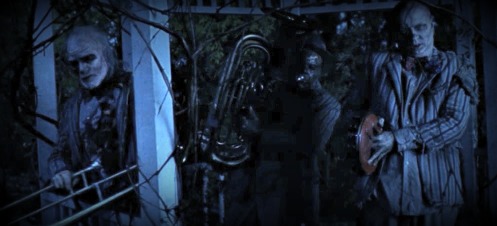Now that I've finished up work on my Master's Project, co-teaching ENG 490W - Zombie Fictions, I'd like to share my model blog entry for our last film blog assignment of the semester. The assignment was as follows (with my blog entry beginning with the picture of Bub):
Over the course of
this semester, we have seen many different presentations of the zombie figure.
For this our 6th and final film blog, I want you to pay particular attention to
the depiction of zombies in George A. Romero's Land of the Dead. In
what ways do these zombies follow the conventions that we have identified
within the zombie fictions that we have looked at over the course of the
semester? In what ways do they violate them?
With these similarities and
differences in mind, make ONE argument about the function of zombies within
this film; i.e. what are these particular zombies doing? Do they operate
symbolically as allegories or metaphors? Are they parodic or satirical?
Of what, and how so? What is George
Romero using this iteration of the zombie to tell us about ourselves?
Once again, you are required to
make ONE explicit critical argument (by
explicit, I mean I want you clearly articulate a thesis statement/main
argument, and to identify it as your
thesis statement by writing it in bold font), and I want
you to support that argument with direct and appropriate evidence from the film
itself.
In many ways, the creatures depicted in George A. Romero’s Land of the Dead exemplify
the traditional zombie figure, as outlined in his original zombie horror
trilogy – Night of the Living Dead, Dawn of the Dead, and the wildly underrated Day of the Dead. Unlike many other recent zombie films, 28 Days Later and Zombieland most notably, the zombies found in Land are dead (not infected), slow (not superhuman), and are
compelled to eat people (instead of just ripping them apart). However, despite
these similarities, the zombies in this film, led by the very impressive Big
Daddy, also present a bit of a departure from the previous 3 entries in Romero’s Dead series. Although there is certainly evidence that the zombies
in Night and Dawn and Day aren’t completely mindless – a tried car door handle here, an
undead Flyboy returning to the hideout there, Bub’s whole zombie prodigy
existence – in Land of the Dead, this limited brain activity is taken even further. These
zombies not only seem to be capable of basic thought and/or residual instinct,
but also appear able to learn, both from each other and from the humans that
consistently abuse them. In this horrific vision of a
world where the zombies aren’t the worst monsters around, a world where zombies
are, in fact, victimized and exploited, Romero presents his viewers with the
unsettling notion that the only thing worse than being killed by your enemy is
deserving it.
The voice-over that begins the movie
actually serves to assert the film’s similarities to its predecessors. Unlike
many other films, who consider the conventions of zombie fictions to be a given, Land of the Dead spends
its first few minutes describing exactly what kind of creatures this film is
concerned with. The first words we hear, “dead people,” don’t tell us very much, but
each successive utterance gives us a clearer and clearer picture of the monster
we are about to encounter (01:13, all times taken from the Amazon Prime rental
version). Using almost the same verbiage as the newscasters in Night of the Living Dead, the voice over
explains that not just dead people, but “the recently departed,” “unburied
human corpses” more specifically, “are returning to life and feeding on the
living” (01:15; 01:17). Echoing the scientist at the beginning of Dawn, we are told that “everyone who dies will become
one of them” and advised that anyone who is bitten “will just become one of
them that much sooner” (01:28; 01:30). However, picking up where Bub left off in Day of the Dead, toward the end of the voiceovers, viewers are
left with a more dire concern, more dreadful even than the idea of undead
creatures that “survive by eating human flesh”: the chance that those creatures
could “develop the power to think, to reason, even in the most primitive ways…”
(01:24; 02:07).
With this awful possibility at the
forefront of our imaginations, the film proper begins. Almost immediately, it
becomes clear that these zombies have a little more going on upstairs, even in
the context of Romero’s relatively-smart-zombie universe. Taking a huge step
from using a rock to try to shatter a window (Night), or holding a baseball mitt (Dawn),
some of the first zombies shown in Land of the Dead are “playing” instruments, grouped together in a
gazebo band (03:14).
The most interesting
and intelligent zombie of the film, though, and one of the more interesting
zombies of zombie fiction period, shows up just moments later after the service
bell dings at Big Daddy’s Gas and repairs and Big Daddy’s zombie dutifully
answers it (03:33). Initially, there’s very little to suggest that Big Daddy is
doing anything beyond acting on residual instinct, no different than Peter’s
explanation for what was drawing the zombies to the mall in Dawn
of the Dead. Any notion that
Big Daddy is just a regular zombie, however, are quickly dispelled when he
notices Riley and Mike scouting the area. Unlike pretty much any zombie we’ve
seen in a Romero film (and most zombies otherwise), Big Daddy does not simply
stop what he is doing and head mindlessly towards the fresh me. Instead, he
seems to grunt an order at the young couple zombies meandering nearby, who
immediately make their way towards the human observers (04:07).
This is something completely new. Even in Day,
where a zombie salutes, shaves, fires a gun, and flips the bird, there isn’t
even a hint of communication between zombies.
Bub, for all his genius, is a singularity, alone in his intelligence. Here,
though Big Daddy is clearly much more aware than the other zombies (he ignores
the "sky flowers" that transfix the rest, for example), they at least display an
ability to be commanded, which puts even the “normal” zombies in Land a
level above every zombie not named Bub in a Romero film. Their awareness, their
ability to “communicate” (one sided though it may be), and their emotion, make
these zombies – not just Big Daddy, but the Couple, the Cheerleader, the
Butcher, and the others too – almost human. More human, I would argue, than the
not actually dead zombies of 28
Days Later and even the domesticated zombies of Fido.
Their humanity, or at least their semblance of humanity, occasions a slight
shift in their positions, however, from one of the monsters, to one of the
victims. In other zombie texts, we often see human characters that are every
bit as horrific as the zombies themselves. But the horror embodied by the
humans in those texts is not enough to cancel out the monstrousness of the
zombie figures. They are just two different kinds of monsters, usually preying
on the same group of survivors. But these zombies, whose human traits serve to
further distance them from people like Mr. Kaufman, Cholo, or Chihuahua, are exploited
and victimized as well.
 |
| Miss America? |
Indeed, the zombies in this film are
not only massacred for fun, they have also been commodified to a startling
degree. They’ve become sport and entertainment, a game, a spectacle, to shoot
paintballs at and have your picture taken with. A safe, neutered thrill.
(27:12) But the zombies aren’t the only ones being exploited outside Fiddler’s
Green; the lower class humans aren’t treated much better – left hungry and
sick, or thrown to zombies for sport (28:17). In Land of the Dead, the zombies are less like the evil humans than
those who are aggrieved. This connection is made for viewers very early on by
Riley, who contends that humans aren’t much different than the stenches: “Isn’t
that what we’re doing, pretending to be alive?” (03:58). When this idea is
reinforced at the end of the movie, after Riley decides not to use Dead
Reckoning to eliminate the zombie horde that has overrun Fiddler's Green
because the zombies are “just looking for a place to go. Same as us,” there is very
much the sense that a reckoning has nonetheless occurred (1:27:49). For all the
gore and viscera that accompanies Big Daddy’s army’s inexorable march to
Fiddler’s Green, the film does not end with a sense of horror, or even ennui,
but justice. Though it would be a stretch to say that every human killed by a
zombie in Land of the Dead deserves it, they all lived in relative degrees of
complacency under a system built upon the outright exploitation and
marginalization of others (Others). Once a group of those marginalized “peoples”
unites and rises up, it’s hard to mourn the casualties along the way. It’s
almost like there’s a lesson to be learned here...




















